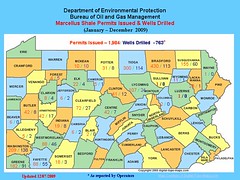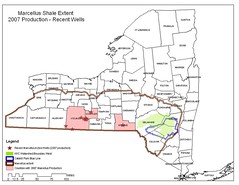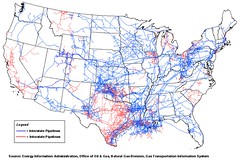EPA will investigate nearby oil and gas development to determine contamination source
Pavillion, WY citizens call for fracking moratorium
Pavillion, WY, August 14, 2009 - This week U.S. Environmental Protection Agency told a group of over 70 that initial investigations found 11 of 39 tested drinking water wells were contaminated. Among the contaminants are toxics used in oil and gas production.
As part of a Superfund investigation, EPA began sampling in March 2009 in the Pavillion, WY area in response to multiple landowners concerns about changes in water quality and quantity following EnCana's increased gas development in the area. Wyoming Department of Environmental Quality (WDEQ) and EnCana had continually assured Pavillion residents that there was no evidence of hydrocarbons or toxic chemicals in their drinking water wells.
 (Look you in the eye and lie.)
(Look you in the eye and lie.)
EPA confirmed the presence of 2-butoxyethanol (2-BE), a known constituent in hydraulic fracturing fluids, in three wells. This is the same chemical that was documented in the water well of Laura Amos, a Colorado landowner, after nearby wells were hydraulically fractured by EnCana. EPA reported that other water contamination, in the Pavillion wells, included methane, as well as adamantanes (a form of hydrocarbon) and six other chemical compounds of concern.
In 2001 EnCana's fracturing operations in Silt, Colorado were linked to methane and other contamination of Ms. Amos' nearby water well. Amos was unable to test immediately for chemical constituents related to hydraulic fracturing as she was unable to identify what chemicals were in EnCana's drilling products. In 2003 Ms. Amos was diagnosed with a rare adrenal cancer and she later discovered that 2-BE had been used in EnCana's fracking products. According to Dr. Theo Colborn at The Endocrine Disruption Exchange, known health effects of 2-BE include elevated numbers of combined malignant and non-malignant tumors of the adrenal gland, kidney damage, kidney failure, toxicity to the spleen, the bones in the spinal column and bone marrow, liver cancer, anemia, female fertility reduction, and embryo mortality.
As a result of the EPA's findings, residents in the Pavillion area are now calling for a halt to EnCana's fracturing operation. "It's very concerning that we are finding known fracturing products and hydrocarbons in our citizens' water wells," says John Fenton. "We'll await EPA's determination as to what is the cause of this contamination. However, in the mean time, we are asking EnCana to ensure no more fracturing occurs in the area."
...
"Full cooperation in this instance requires that EnCana fully disclose what products and chemicals have been used in the Pavillion/Muddy Ridge fields," says Deb Thomas, organizer for the Power River Basin Resource Council and the Pavillion Area of Concerned Citizens. "This shows why federal regulation of fracturing and drilling operations is so important. We have been seeking answers from EnCana and the State of Wyoming for years. We are very pleased that EPA is now getting results. All citizens deserve clean water."
In June, the Fracturing Responsibility and Awareness of Chemicals Act (S. 1215/HR 2766) was introduced to require disclosure of fracturing chemicals to public agencies and to lift the exemption for hydraulic fracturing under the Safe Drinking Water Act. The legislation, known as the FRAC Act ensures that a federal minimum standard would prohibit endangerment of underground sources of drinking water while allowing states flexibility in implementing that standard.
***Urge Congress to vote for the FRAC Act, removing exemptions for hydraulic fracturing from the Safe Drinking Water Act. You can get contact information for your senators and representatives from the side bar on the left. WRITE NOW!***
"Citizens throughout the country have been reporting changes in their water well's quality and quantity after nearby hydraulic fracturing operations for years and voicing concerns about both short and long-term health effects," said Jennifer Goldman of Earthworks' Oil and Gas Accountability Project. "The FRAC Act is critical to ensuring that we know what toxics are being injected into and near our aquifers and to holding the oil and gas industry accountable for the environmental and health impacts."
DEMAND ACCOUNTABILITY!



















No comments:
Post a Comment